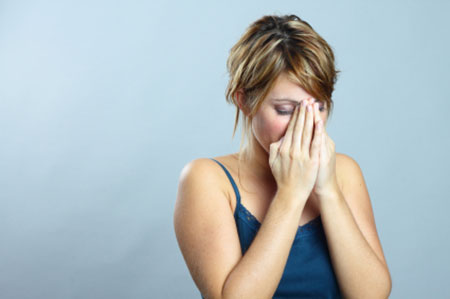Many women’s bodies react to hormonal fluctuations with head pain. This is often in a cyclical fashion that corresponds to the monthly ebb and flow of estrogen and progesterone. Conventional doctors and headache specialists often overlook this common headache trigger. Even when they don’t, little is offered in the way of long-term solutions. Most primary care physicians will write a prescription for a pain reliever or birth control pills. Or they may refer these patients to their ob-gyn.

I am happy to report that many women find their headaches become less frequent or disappear altogether once they address their hormonal imbalance. This could be through diet, optimal nutrition or sometimes short-term bioidentical hormonal supplementation.
Even if headaches have never been a concern for them before, many women may become more sensitive to their own hormones as they get older. As they enter perimenopause, women may begin to experience hormonal headaches or menstrual migraines for the first time. The majority of these women experience a dramatic improvement in their headaches post menopause.
Addressing the root causes of hormonal headaches and migraines with a holistic approach can be effective. It can take a bit longer than popping a pill. But I assure you, there are many additional, long-term benefits following relief from your headache.

Who gets hormonal headaches?
Women who are susceptible to hormonal fluctuations often suffer with menstrual headaches or migraines just prior to the onset of menses when there is a natural drop in progesterone levels. But headaches may also occur when estrogen and other hormones spike. Or they may occur during menses itself, when estrogen and progesterone have bottomed out.
Hormonal headaches can come on suddenly or become more unpredictable in perimenopause or at menopause, when hormones are really shifting. Some women who have never experienced headache or migraine before begin to suffer with regularity. In my practice, I have seen women with incapacitating migraines in their initial year of menopause, similar to those they recall experiencing at puberty/menarche. But for the 40 years in between, they had no headache pain! Every woman is different. And tuning into your body’s own unique signals is the first step in any kind of natural prevention or treatment.
As with any other kind of headache or migraine, tracking the onset of your pain using a journal will help you get a handle on any pattern and potential cause. If you are still menstruating, I recommend charting the days of your period for a few months with the same journal. This will help you understand the basic ebb and flow of hormones in your system each month. And how these may relate to your headache or migraine.
You should be aware that most headaches are multifactorial and may have overlapping triggers. Hormones are often part of the headache/migraine cascade, even if they haven’t been officially identified. Any woman with regular headaches or migraines can benefit from improving her overall ratio of estrogen and progesterone.
The estrogen–progesterone connection
Most hormonal headaches occur when levels of estrogen are out of balance in relation to natural levels of progesterone. As noted above, for many women this may be correlated with the naturally lower levels of progesterone that are normal before their period starts, when progesterone levels naturally drop off. Or less frequently, it may be a state of true progesterone deficiency. Some women, especially during perimenopause and menopause, may have unnaturally low progesterone levels that require supplementation. Only a blood test or saliva test can tell you what your levels actually look like.
When to test
At Women’s Health Network, we recommend having progesterone levels tested during the mid-luteal stage of your menstrual cycle. Depending on the number of days in your cycle, this usually occurs after ovulation. That occurs somewhere around day 21 of a classic 28–day cycle. Some practitioners provide a simple saliva test; others recommend the more expensive blood test.
A typical finding in women of all ages during these tests is that “baseline” progesterone levels are acceptable but the ratio of progesterone to estrogen is off. This doesn’t mean your estrogen levels are abnormal. Although, if you’re worried, you can test your estrogen levels as well with a blood panel. Most of the time it simply means the level of estrogen is out of sync with the progesterone level.
How does the ratio of estrogen to progesterone go awry? It may be that you are “estrogenic” and your body readily converts progesterone into estrogen. Or you may be susceptible — as many of us are — to the rising level of xenoestrogens and other endocrine disruptors in our environment. These substances mimic estrogen in the body and can tip your delicate hormonal balance. (You may also have other dietary or stress–related triggers in addition to your hormones). Once you suspect that your headaches or migraines have a hormonal component, you can do something about them.
Preventing hormonal headaches naturally
Getting to the root of these hormonal headaches means dealing with a temporary or chronic imbalance of estrogen in relation to progesterone. A healthy diet that avoids or eliminates simple carbohydrates, refined sugars, and processed foods is always the first step. Our lifestyle and nutritional guidelines can get you started.
The second step is to decrease or eliminate toxins that can be exacerbating your hormonal imbalance. It’s always a good idea to be on the lookout for endocrine–disrupting chemicals in your environment and avoid them as much as possible. Even the perfume in your cosmetics can trigger a migraine.
Supplement to fill dietary gaps
The third step is to fill in any dietary gaps with nutritional supplements. Good choices to begin with are core nutrients like those offered in our Health Protocols — a rich multivitamin, essential fatty acids, and calcium/magnesium. Believe it or not, all are crucial to supporting your hormone balance and restoring a good progesterone-to-estrogen ratio. Additional nutritional measures include non-GMO soy, fresh ground flax seed, or other foods high in fatty acids, fiber, and isoflavones (red clover).
Specific supplements can nip migraines in the bud. Certain herbs have been used to prevent and treat headaches by herbalists for thousands of years. At least two are now solidly confirmed by scientists as effective in clinical trials. These are butterbur (Petasites hybridus) and feverfew (Tanacetum parthenium). The mineral magnesium and Vitamin B2 (riboflavin) have both been demonstrated to decrease migraine frequency in people who normally have multiple migraines a month. By effective, I mean at least a 50% reduction in migraine frequency in some women.
Today there are various safe, over-the-counter migraine prevention formulas that combine these natural ingredients. I’d encourage you to look into them because they can be especially helpful in combination formulas. For example, Migravent contains all four of the above ingredients: feverfew, butterbur, magnesium, and riboflavin.
There are additional plant extracts and foods long used in various cultures to ameliorate headaches and other symptoms associated with fluctuating hormones. These include soy, black cohosh (Cimicifuga racemosa) and dong quai (Angelica sinensis). While I generally recommend that anyone considering the use of naturopathic remedies consult the advice of a qualified practitioner, you can also talk to your regular healthcare practitioner or call one of our Advisors. For many women, changes in diet, nutrition level, and lifestyle are all they need to feel better.
Consider hormone supplementation
Once you’ve established a basic core of nutrition, you may find that adding natural hormone supplementation, specifically bioidentical progesterone at the right time of the month, provides great relief. I recommend you work with a qualified healthcare practitioner to explore the use of bioidentical hormone therapy. Here are some guidelines from Women’s Health Network to discuss with your practitioner:
For premenstrual and perimenopausal headaches and migraines
The most likely triggers for headaches that occur premenstrually, or those in perimenopause, include a sensitivity to the natural drop-off in progesterone levels as the luteal phase of your cycle (second half) progresses, or alternatively, an ongoing progesterone deficit. For this pattern we recommend you apply the hormone cream as directed during the last two weeks of your cycle.
Headaches and migraines during your period
If menstrual headaches persist throughout your period even after you’ve tried the natural balancing measures, it may be helpful to try prescription low dose bioidentical estrogen supplementation, such as the estradiol patch, during your period. Talk to your healthcare practitioner about this.
A word about hormone use and hormonal headaches
While we believe that natural (bioidentical) hormone supplementation is an important therapeutic for some women, and can be particularly useful in treating hormonal headaches, hormones — even if they are natural — are very powerful. That’s why we recommend a blood test for any woman who is interested in using hormones, especially if she is nearing menopause. We think of any kind of hormonal supplementation as a bridge to natural, self-sustaining hormonal balance, not an end solution.
If you are still menstruating or within a year of menopause, you may want to discuss a trial of low-dose bioidentical progesterone, as described above, with your healthcare provider. In combination with other lifestyle changes it may help your body become more progesterone–balanced without further supplementation. For headache or migraine relief, I do not suggest the use of synthetic progestins like Provera or synthetic HRT combinations. They act more as vasoconstrictors and can actually worsen headache symptoms. The pharmacokinetics of real, bioidentical progesterone are entirely different as it is metabolized instinctively by the body.
Even with a low-dose, bioidentical hormone you should continue to exercise caution and tune in to your body’s signals. If you are using bioidentical progesterone and experience increased headache or other PMS symptoms such as breast tenderness, or you begin to sense these symptoms at ovulation, you may be hard-wired to convert extra progesterone into estrogen, in which case additional progesterone may not be a good choice for you. With any persistent heavy bleeding, unusual spotting, breast tenderness, or other serious symptoms while using bioidentical progesterone products, discontinue use and contact your healthcare provider. Further evaluation may be needed.
Rescue treatments for hormonal headache pain
Becoming aware of the timing of your hormonal headaches or migraines can certainly help you decrease their frequency with preventive measures. I encourage you to read our article on chronic headaches, particularly the section on migraines, to learn more about migraine patterns and theories. Nevertheless, even women who adopt the healthiest lifestyle and dietary habits and hormonal–balancing measures can get the occasional painful migraine. Life is full of stressors and you can’t be on top of all of them all the time. When hormonal headaches and migraines arise acutely despite your best efforts, prompt use of rescue treatment as early as possible will deliver the most effective relief.
There are a few rescue meds to have in your medicine chest but use these with caution. Take only as directed, and never use any drug without discussing your lifestyle and other prescriptions with your practitioner first.
NSAIDs
Nonsteroidal anti-inflammatories (NSAIDs) can be particularly helpful if used early and at your optimal dose. I suggest ibuprofen (brand names Advil or Motrin) with food, up to 800 mg every 8 hours, no more than two days in any given week (max is 2400 mg per 24-hour period). However, some women really respond well to plain old-fashioned aspirin. And some swear by Excedrin Migraine, which contains acetaminophen, aspirin and caffeine. If you are in the habit of taking NSAIDs, please read the section of our chronic headache article on avoiding rebound headaches.
If you are trying to conceive or are pregnant, acetaminophen (aka paracetamol, or brand name Tylenol) is the only recommended choice in the NSAID category. Ibuprofen and aspirin can cause birth defects and other serious problems. So be sure to discuss it with your midwife or obstetrician before using any medications. Fortunately for hormonal headache sufferers, pregnancy is often a time of reprieve.
Triptans
These anti-migraine agents were once believed to work by binding to serotonin receptors in the brain to constrict blood vessels and reduce inflammation. This theory is being challenged and although it remains unclear how the triptans work, this treatment can help some women. Some headache experts suggest that women who observe that their migraines or debilitating headaches occur predictably on certain days, e.g., day 1 or 2 of menses, take a triptan once or twice a day on those days as prophylaxis. Although this usage has not been formally approved by the FDA, you can ask your headache specialist about this option. Imitrex, a popular brand of triptan, and others are pain formulations with long-acting effect. Again, they work best when taken as close to the migraine onset (prodrome) as possible.
If one triptan doesn’t work well for you or you had side effects, another formula may be better. So don’t despair, and try another one. We’re all different with individual responses and it may just take time to figure out the right solution for you. Triptans are not advisable for use in pregnancy. And they must be used with caution if you’re also on an SSRI antidepressant. Triptans come in pills, orally-disintegrating tablets, nasal sprays, subcutaneous injections, and transdermal compressed medication (patch).
Other prescription migraine treatments
For a complete list of migraine treatments used in conventional clinical settings, visit the website of the National Headache Foundation. Many of these treatments were developed to address other medical conditions, such as heart disease, high blood pressure, depression, congestion, etc. But they were coincidentally found to help prevent the acute pain of migraines. Although these treatments can be effective, they can take about a month to kick in. And need to be taken every day in order to work. All of these drugs must be taken under strict medical supervision. If you are currently taking any of these medications, it is still safe to consider all of the other natural measures we’ve discussed above.
As headaches have so many potential contributing factors, I also suggest you review our list of ten ways to eliminate chronic headaches naturally. Implementing these practices, too, will certainly help with hormonally-driven headaches and migraines. Hopefully, with time, you will find yourself relying less and less on heavy-duty pain-relievers and more on your body’s innate mechanisms for staying balanced and healthy.
Balanced and pain-free
While headaches may seem to be “all in your head,” the most effective treatment for any health problem takes into account the needs of your whole body. Unlike conventional medicine which only treats the pain, an integrative approach restores the baseline ratio of hormones. If you and your practitioner think hormones are causing your headaches, it may actually be good. It means that you have the opportunity to take effective proactive measures.
By focusing on nutrition, proper supplements and a healthy lifestyle, with careful use of natural hormonal support when needed, you can decrease both the frequency and intensity of your hormonal headaches. You may even find that other symptoms dissipate as well. This approach may require a few months for full results. But once you get there, you may find your are completely free of headaches!
NOTE: Severe, blinding pain that comes on suddenly with no prior migraine history should be taken seriously. If you are experiencing new or different headaches, severe headaches or headaches with associated sensory or neurological symptoms, seek immediate help at your local hospital’s emergency department. DO NOT WAIT.










